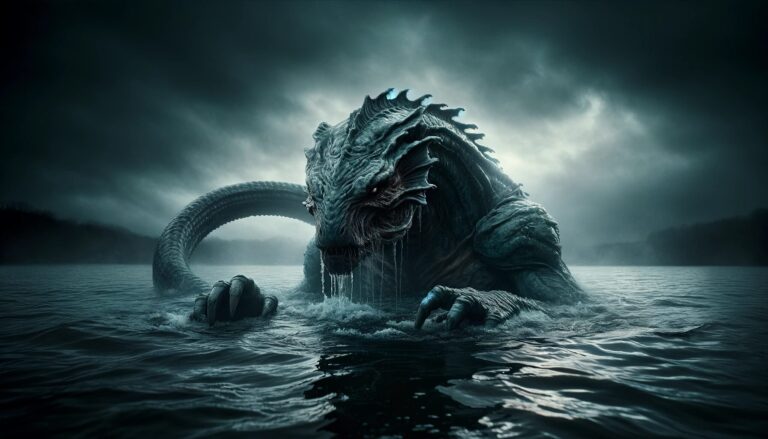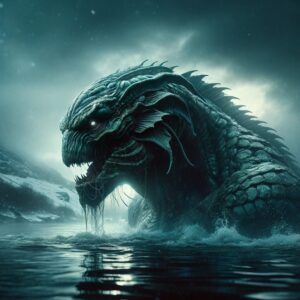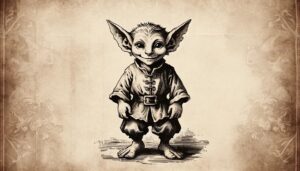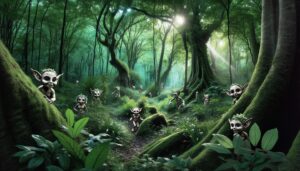Table of Contents
The Abac is sometimes spelled as “Afanc,” “Abhac,” or “Adanc,” depending on the specific region and time period in which the stories were told. It’s often depicted as a dangerous and monstrous creature inhabiting lakes and rivers, capable of causing floods and other natural disasters.Some tales, heroic figures or saints would confront the Addanc to protect their communities, and the creature’s defeat would bring about peace and safety. The Addanc is an interesting example of how mythology and folklore can vary in different cultures and regions.
Origin
The origin of the Addanc or Afanc creature in Welsh mythology is rooted in the folklore and legends of Wales. Like many mythological creatures, its exact origins are not well-documented, and it has likely evolved over centuries through oral traditions and storytelling.
The Addanc is closely associated with Welsh lakes and rivers, particularly in the region of Snowdonia. It’s possible that the legend of the Addanc was inspired by observations of unusual or unexplained natural phenomena, such as large waves, whirlpools, or other aquatic occurrences that people of the time couldn’t fully understand. Over time, these observations may have been incorporated into local legends and tales of monstrous water creatures.
The creature’s name, “Addanc,” and its variations like “Afanc” or “Abhac,” are thought to have Celtic origins, but the details of its earliest appearances in Welsh mythology are not well-documented. Like many mythical creatures, the Addanc likely served as a way to explain the mysteries and dangers of the natural world, as well as to entertain and frighten through storytelling.
The physical description of the Abac, also known as the Afanc or similar names, can vary depending on the specific version of the legend and the storyteller. However, there are some common characteristics often associated with this water monster in Welsh folklore:
Aquatic Creature: The Abac is typically described as an aquatic monster that dwells in lakes or rivers, often lurking beneath the water’s surface.
Monstrous Appearance: It is commonly depicted as a fearsome and monstrous creature with a grotesque appearance. The specific details of its appearance may vary, but it is often described as having a large and serpentine or dragon-like body.
Clawed Limbs: Some versions of the creature describe it as having powerful clawed limbs or webbed feet, which it uses to thrash about in the water.
Destructive Behavior: The Abac is known for causing havoc and destruction in its habitat. It is said to create storms, whirlpools, and floods that threaten nearby communities.
Capture and Defeat: In many legends, a heroic figure like Peredur or another brave individual is called upon to capture or defeat the Abac. This may involve using ropes or other means to subdue the creature.
Transformation: In some variations of the story, the Abac can transform or change its shape, making it even more elusive and difficult to capture.
Personality
In Welsh folklore and mythology, the Abac (or Afanc) is typically portrayed as a malevolent and destructive creature with a menacing personality. Common personality traits and characteristics associated with the Abac:
Destructive: The Abac is known for its destructive behavior, often causing floods, storms, and other natural disasters that threaten the safety of nearby communities. Its actions are usually seen as malevolent and harmful.
Terrifying: The Abac is described as a terrifying and fearsome creature, capable of striking fear into the hearts of those who encounter it. Its appearance and actions are meant to inspire dread.
Aggressive: It is often depicted as an aggressive and hostile creature, thrashing about in the water and posing a danger to anyone who comes near its domain.
Elusive: The Abac is often portrayed as an elusive and cunning creature, making it difficult to capture or defeat. It may use its wits and shape-shifting abilities to evade capture.
Mysterious: Like many mythical creatures, the Abac carries an air of mystery and the unknown. Its origins and motivations are often shrouded in myth and legend.
Symbol of Natural Forces: In some interpretations, the Abac may also symbolize the destructive and uncontrollable forces of nature, serving as a cautionary tale about the power and unpredictability of the natural world.
In Welsh folklore, the Abac (or Afanc) is a mythical water monster known for its menacing presence and often attributed with various special abilities and traits. These abilities may vary depending on the specific version of the legend, but here are some of the common special abilities associated with the Abac:
Shape-Shifting: In some versions of the legend, the Abac has the ability to change its shape, making it difficult to detect and capture. It may transform into different forms to evade capture by heroes or hunters.
Great Strength: The Abac is often described as having immense physical strength, allowing it to thrash about in the water, create storms, and pose a significant danger to anyone who approaches its habitat.
Control Over Water: Some versions of the legend attribute the Abac with the power to control and manipulate water, causing floods, whirlpools, and other water-related disasters in the areas where it dwells.
Illusionary Magic: In certain stories, the Abac may use illusionary magic to deceive and confuse those who attempt to capture or confront it, further complicating their efforts.
Elusiveness: The Abac is known for its ability to evade capture and remain hidden beneath the water’s surface, making it challenging to locate and subdue.
Regeneration: In some variations of the legend, the Abac possesses regenerative abilities, allowing it to heal wounds and injuries inflicted upon it, making it even more resilient.
These special abilities contribute to the creature’s reputation as a formidable and elusive antagonist in Welsh folklore, often requiring clever and heroic efforts to overcome its threat to local communities. Different storytellers and regions may emphasize different aspects of the Abac’s abilities in their retellings of the legend.
In Modern Usage and Symbolism
Cultural Heritage: The Abac is a part of Welsh cultural heritage and mythology, and it may be featured in local festivals, storytelling events, or educational programs to celebrate and preserve Welsh folklore.
Tourism: Some regions in Wales may use the legend of the Abac as a tourist attraction, incorporating it into the marketing of their natural landscapes and historical sites associated with the creature.
Environmental Awareness: The Abac legend can be used symbolically to raise awareness about environmental issues, especially those related to water conservation and the preservation of natural habitats. It can serve as a cautionary tale about the impact of human activities on the natural world.
Art and Literature: Artists, writers, and authors may draw inspiration from the Abac and incorporate elements of the legend into their works, creating new stories, artwork, or poetry that pay homage to Welsh mythology.
Metaphor for Natural Forces: The Abac can symbolize the power and unpredictability of natural forces, serving as a metaphor for the potential dangers and wonders of the natural world.
Adaptation in Pop Culture: While not as well-known as other mythical creatures, the Abac may occasionally make appearances in modern fantasy literature, games, or media, adapted to fit contemporary storytelling.
Ralated and similar creatures
Creatures similar to the Abac (Afanc) can be found in the folklore and mythology of various cultures around the world. These water-dwelling monsters are often depicted as dangerous and mysterious beings, and they share common themes with the Abac. Examples of related and similar creatures from different mythologies:
Loch Ness Monster (Nessie):
Origin: Scottish folklore
Description: Nessie is a legendary creature said to inhabit Loch Ness in Scotland. It is often described as a long-necked, serpentine creature resembling a plesiosaur.
Origin: Japanese folklore
Description: The kappa is a water-dwelling creature found in Japanese mythology. It is typically depicted as a humanoid with a water-filled dish on its head and a mischievous nature.
Ogopogo:
Origin: Indigenous folklore of the Okanagan Nation in Canada
Description: Ogopogo is a lake monster said to reside in Okanagan Lake in British Columbia, Canada. Descriptions vary, but it is often described as a long, serpent-like creature.
Selkie:
Origin: Scottish and Irish folklore
Description: Selkies are mythical creatures capable of transforming from seals into humans. They are often associated with the sea and are known for their enchanting songs and captivating beauty.
Kraken:
Origin: Scandinavian folklore
Description: The kraken is a legendary sea monster that is said to dwell off the coasts of Norway and Greenland. It is typically depicted as a massive, tentacled creature capable of sinking ships.
Charybdis:
Origin: Greek mythology
Description: Charybdis is a sea monster in Greek mythology, often associated with whirlpools. It is said to create powerful currents that can be deadly to sailors.
Mokele-Mbembe:
Origin: Cryptid folklore of Central Africa
Description: Mokele-Mbembe is a legendary cryptid believed to inhabit the Congo River basin. Descriptions vary, but it is often likened to a dinosaur or sauropod-like creature living in the water.
These creatures, like the Abac, often play a role in local legends and stories, where they may be seen as both a source of fascination and a potential threat to those who venture into their domains. They continue to captivate the human imagination and inspire tales of mystery and adventure.
FAQ
What is the Abac or Afanc?
The Abac, also known as the Afanc, is a mythical water monster from Welsh folklore.
Where is the Abac typically said to live?
It is said to inhabit lakes and rivers in Wales, with stories often associated with Lake Llyon Llion.
What does the Abac look like?
The creature is often described as a fearsome, serpentine or dragon-like creature with destructive tendencies.
What special abilities are attributed to the Abac?
The Abac is said to have abilities like shape-shifting, great strength, control over water, and elusiveness.
Is the Abac a real creature?
No, the Abac is a mythical creature from Welsh folklore and is not considered a real animal.
Are there similar creatures in other cultures?
Yes, various cultures have legends of water monsters, such as the Loch Ness Monster, kappa, and kraken.
What is the significance of the Abac in modern times?
The Abac remains a part of Welsh cultural heritage and may be used in festivals, tourism, and as a symbol for environmental awareness.
Has the Abac appeared in popular culture?
Occasionally, it may make appearances in modern fantasy literature and media, adapted to fit contemporary storytelling.
What is the Abac's role in Welsh mythology?
The Abac is often portrayed as a malevolent force that threatens communities and must be confronted by heroes.
What is the moral lesson of Abac legends?
Abac legends often emphasize the triumph of courage and heroism over adversity and danger.
Are there any famous Abac legends?
One notable legend involves the hero Peredur who defeated the Abac to protect his community.
Do people still believe in the Abac today?
The Abac is considered a creature of folklore and mythology, and belief in its existence is not common in modern times.
Are there any specific rituals or traditions associated with the Abac?
There are no widely known rituals or traditions associated with the Abac in contemporary culture.
Is there scientific evidence of the Abac's existence?
No scientific evidence supports the existence of the Abac or similar water monsters.
How has the Abac's appearance changed over time?
The creature's appearance can vary between legends and storytellers, but it is often described as monstrous and aquatic.






